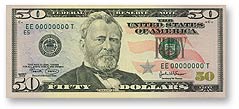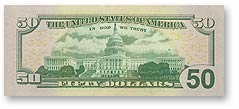NEW YORK (CNN/Money) - The Bureau of Engraving and Printing Monday unveiled a redesigned version of the $50 bill, the latest in a series of currency redesigns intended to thwart counterfeiters.

| |
|
The new $50 front (click to enlarge)
|
|
The decision to redesign the $50 was made last year, and announced simultaneously with the new $20. Those smaller-denomination bills were released to the public beginning in October 2003.
The new look of the $50s was displayed at a ceremony at a printing plant in Fort Worth, Tex., where the notes are to be made. Production will begin this summer, according to Bureau spokeswoman Dawn Haley, and the new $50s should enter general circulation at the end of September or beginning of October.

| |
|
The new $50 back (click to enlarge)
|
|
Generally speaking, the bills follow the aesthetic guidelines set out by the $20.
For example, pastel tones will augment the old green and black color scheme, even more vibrantly than on the new $20. Ulysses S. Grant will continue to be pictured, but his face appears more prominently, as Andrew Jackson's does on the $20.
The number 50 is presented in a variety of newly introduced fonts. On the back, the engraving of the Capitol Building has been altered slightly as well.
| Fun Facts about the $50
|

|
|
| • | Ulysses S. Grant has been on the $50 since 1913.
|
|
|
|
| • | The average lifespan of a $50 is five years.
|
|
|
|
| • | There are approximately 1.2 billion, or $58.2 billion, $50s in circulation.
|
|
|
|
|
"This $50 note is beautifully designed and includes important anti-counterfeiting features," said Federal Reserve Board governor Mark Olson, in a speech made at the unveiling ceremony. Fighting note forgery, he added, "is a job that's never finished."
Although colorization is the most immediately visible difference between the new and old bills, other anti-counterfeiting features may be more technologically significant. These include an embedded plastic strip running vertically; a watermark image engrained into the paper itself; and color-shifting ink, whose appearance changes as you tilt the bill against light.
When the $20 was unveiled, the Bureau launched a large, consumer-focused marketing campaign to explain the redesign to the public. The government spent about $12 million in advertising, and arranged product placement deals to insert the bills onto a number of national TV shows, including the game shows "Jeopardy" and "Wheel of Fortune," and sporting events aired on ESPN and ABC.
This time, "there will be more of a business-to-business focus to our public education efforts," said Haley. The Bureau is working with vending machine makers and others to ensure a smooth rollout when the new $50s are released in the fall.
When the $20 launched, a snafu arose involving self-service cashiers, those new, do-it-yourself checkout machines. A handful of the machines did not update their optical-recognition software to read the redesigned notes -- a small glitch, but one that left the BEP red-faced nonetheless.
"The technology was so new, we missed a few," acknowledged Haley.

|

